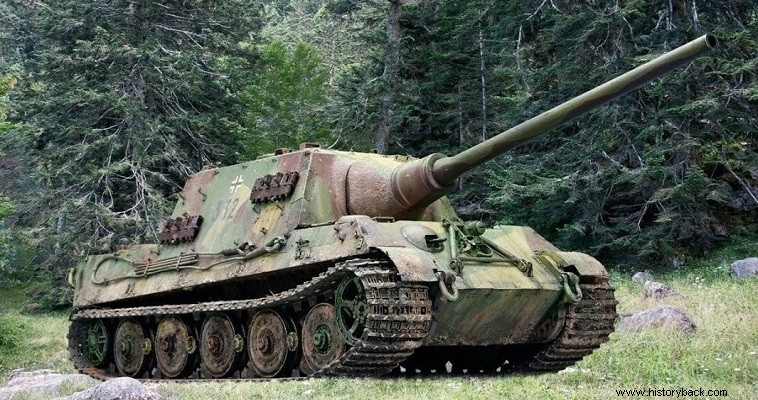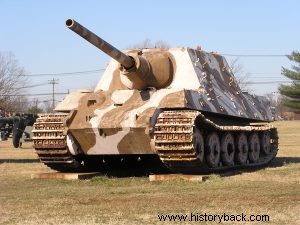
The Jagdtiger tank hunter (Tiger hunter) was a development of the Tiger II battle tank (Pz VI Königstiger – royal Tiger). It was the heaviest and most powerful armored vehicle to enter service during World War II.
It had a weight of 71 tons, a maximum armor thickness of 250 mm. maximum road speed of 38 km per hour, and a crew of six. It was armed with the beastly 128mm PAK 44 gun. 55 caliber which could destroy any allied tank from a long distance. In one case a projectile went through the walls of a house and destroyed an American tank hiding behind the house!
A disadvantage, however, was that the cannon was loaded separately with the projectile and the propellant charge. That's why there were two chargers in the vehicle. Also the engine was underpowered in relation to its weight and understandably the vehicle suffered from the well-known "childhood diseases" of hasty development which resulted in mechanical problems.
Fortunately for the Allies very few Jagdtiger were produced which equipped only two heavy tank divisions the 512th and 653rd.
The 653rd Regiment
A three-vehicle platoon of the 653rd Division took part in the German attack on Strasbourg in January 1945. On 17 January two vehicles destroyed American-held fortifications on the Mazinot Line from a distance of 1,000 m. The command was strengthened and, according to some sources, from an operational unit that it originally had, it reached the number of three combat islands with a total of 42 vehicles.
But soon only 22 remained operational. On March 14, 1945 Jagdtigers destroyed a phalanx of American M4 Sherman tanks from a safe distance without suffering any casualties. The next day the division launched a counterattack but lost five vehicles to American aircraft.
On 22 March just three Jagdtigers destroyed 23 US Sherman tanks and M10 tank destroyers without casualties. On the same day, another ulama destroyed nine tanks and two half-tracks, losing one vehicle to American artillery.
The general had no further successes in the face of overwhelming numerical enemy superiority. The last four vehicles of the 653rd fought with the 1st SS Panzer Division.
The 512th Regiment
The 512th Heavy Tank Division had only two islands, each with 10 Jagdtiger. It was headed by Major Albert Ernst. The 2nd Ili was led by Lieutenant General Otto Karius, a Panzer ace with around 150 hits. In March 1945 the division was sent to Remagen to deal with American forces that had crossed the Rhine.
Four vehicles were immobilized due to mechanical failures. Another was accidentally destroyed by German infantry and another was immobilized by falling into a shell pit.
On one occasion two Jagdtigers spotted an American phalanx but the commander was afraid to open fire so as not to reveal the position of the vehicles to the enemy air force. The allied aircraft had indeed become the terror of the German tanks. The leader preferred to retreat, but on the way the two vehicles were immobilized due to a mechanical failure.
At the same time, however, Ernst's platoon destroyed 30 American Shermans at Herborn by firing at them from a distance of more than 3 km. On April 8, Karius' platoon destroyed 20 Sherman armored vehicles near Una.
Ernst's platoon was left with four Jagdtigers and was reinforced with Pz IV tanks and Stug IV assault guns. On April 11, having deployed in an ambush, the platoon tore into an American phalanx, destroying 11 Sherman tanks and 40 more vehicles. The Americans called in the air force to intervene. Only one Jagdtiger was destroyed by the attacks.
Between April 12-15, Ernst's company continued to fight against the Americans, destroying four more Shermans. On April 16 Ernst surrendered. The last three Jagditigers were delivered to the Americans. Karius surrendered with his unit on May 7.

